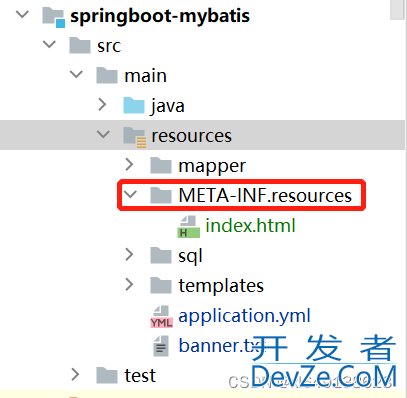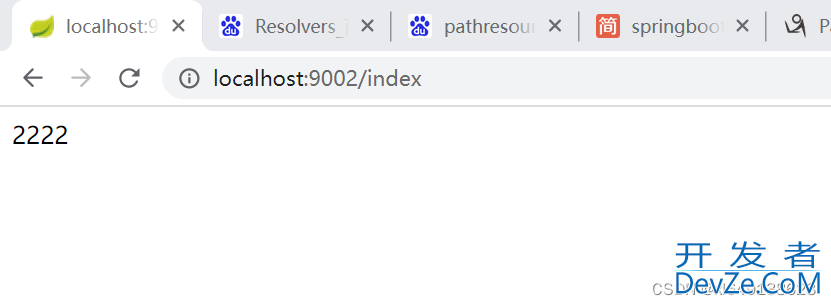SpringBoot在项目中访问静态资源步骤分析
在springboot项目中如果要在不集成templates的情况下访问静态资源需要做以下配置
1.在项目的application.yml文件中做如下配置
spring:
profiles: active: dev mvc: view: prefix: / suffix: .html
重点在

配置后生成为WebMvcProperties 配置类。该配置类中有一个内部类View
@ConfigurationProperties(prefix = "spring.mvc")
public class WebMvcProperties {
View类可以配置视图的前缀和后缀
public static class View {
/**
* Spring MVC view prefix. 前缀
*/
private String prefix;
/**
* Spring MVC view suffix. 后缀
*/
private String suffix;
2.在项目的resource路径下新建文件夹
在ResourceHttpRequestHandler类的getResource方法中调用了getLocations()方法。
protected Resource getResource(HttpServletRequest request) throws IOException {
String path = (String) request.getAttribute(HandlerMapping.PATH_WITHIN_HANDLER_MAPPING_ATTRIBUTE);
if (path == null) {
throw new IllegalStateException("Required request attribute '" +
HandlerMapping.PATH_WITHIN_HANDLER_MAPPING_ATTRIBUTE + "' is not set");
}
path = processPath(path);
if (!StringUtils.hasText(path) || isInvalidPath(path)) {
if (logger.isTraceEnabled()) {
logger.trace("Ignoring invalid resource path [" + path + "]");
}
return null;
}
if (isInvalidEncodedPath(path)) {
if (logger.isTraceEnabled())编程客栈 {
logger.trace("Ignoring invalid res编程ource path with escape sequences [" + path + "]");
}
return null;
}
ResourceResolverChain resolveChain = new DefaultResourceResolverChain(getResourceResolvers());
//重点关注此处
Resource resource = resolveChain.resolveResource(request, path, getLocations());
if (resource == null || getResourceTransform编程ers().isEmpty()) {
return resource;
}
ResourceTransformerChain transformChain =
new DefaultResourceTransformerChain(resolveChain, getResourceTransformers());
resource = transformChain.transform(request, resource);
return resource;
}
getLocations()方法返回的locations来自与springboot项目,其中时配置类ResourceProperties赋值。赋值的数据为
"classpath:/META-INF/rewww.devze.comsources/",
"classpath:/resources/",
"clwww.devze.comasspath:/static/",
"classpath:/public/"
四个路径
@ConfigurationProperties(prefix = "spring.resources", ignoreUnknownFields = false)
public class ResourceProperties {
private static final String[] CLASSPATH_RESOURCE_LOCATIONS = {
"classpath:/META-INF/resources/", "classpath:/resources/",
"classpath:/static/", "classpath:/public/" };
/**
* Locations of static resources. Defaults to classpath:[/META-INF/resources/,
* /resources/, /static/, /public/].
*/
private String[] staticLocations = CLASSPATH_RESOURCE_LOCATIONS;
所以要访问静态资源需要配置到这四个路径下,如果所示

3.API端按如下编码
@Controller
public class PageApi {
@GetMapping({"/", "/index"})
public String toPage(String id){
return "index";
}
}
总结:
按照上面的配置后我们就可以访问到静态资源。

到此这篇关于SpringBoot在项目中访问静态资源步骤分析的文章就介绍到这了,更多相关SpringBoot访问开发者_C学习静态资源内容请搜索我们以前的文章或继续浏览下面的相关文章希望大家以后多多支持我们!







 加载中,请稍侯......
加载中,请稍侯......
精彩评论